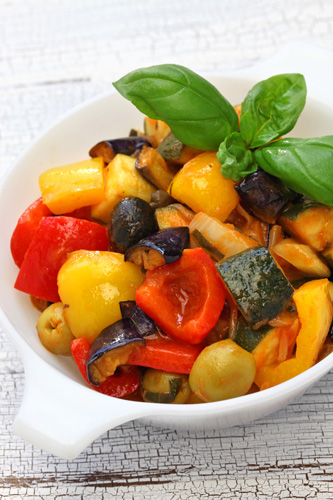An authentic Italian recipe from our kitchen to yours. Buon
Appetito!
Ingredients
- 1 1/2 to 2 pounds eggplant
- 1 large red bell pepper
- 1 large yellow bell pepper
- 2 tender stalks of celery
- 1 medium red onion
- 2 large tomatoes
- 1/2 cup castelvetrano or other green olives, drained and rinsed (use pitted or unpitted per your preference)
- 2 tablespoons salted capers
- 1/2 cup white wine vinegar
- 1 tablespoon sugar
- Toasted pine nuts (optional)
- Fresh basil leaves (optional)
- Extra virgin olive oil
- Salt
- Vegetable oil for frying
Directions
1.
Rinse
the
eggplant
and
remove
any
stems.
Cut
the
eggplant
into
1-inch
pieces.
Place
the
pieces
into
a
colander
and
toss
with
1 -
2
teaspoons
salt.
Place
a
heavy
plate
or
bowl
over
the
eggplant
to
weigh
it
down
and
press
out
its
liquid.
Set
the
colander
aside
and
let
the
eggplant
drain
for
45
minutes
to 1
hour.
This
removes
the
bitter
taste
from
the
eggplant.
2.
In
the
meantime,
place
the
salted
capers
in a
small
strainer
and
rinse
with
water.
Once
rinsed,
place
the
capers
in a
bowl
with
water
and
let
sit
for
15
minutes
to
further
remove
more
of
the
salt.
3.
Rinse
the
peppers,
and
remove
the
stems
and
seeds.
Cut
the
peppers
into
strips
roughly
1/2
to
3/4
inch
wide.
4.
Rinse
the
celery,
remove
the
ends,
chop
it
into
small
pieces
and
set
aside.
5.
Slice
the
onion
into
1/4
inch
slices
and
set
aside.
6.
Rinse
and
core
the
tomatoes,
then
chop
them
and
set
aside.
7.
In a
large
pot,
add
about
2
inches
of
your
preferred
oil
for
frying.
Heat
the
oil
over
medium
high
heat
to
roughly
350
degrees.
While
waiting
for
the
oil
to
come
to
temperature,
line
a
sheet
pan
or
large
plate
with
paper
towels.
8.
After
the
liquid
has
drained
from
the
eggplant,
thoroughly
rinse
the
eggplant
in
the
colander
under
fresh
water
to
remove
the
salt.
Drain
the
water
from
the
colander
well
and
pat
the
rinsed
eggplant
with
paper
towels
to
dry
them
further.
9.
When
the
oil
has
come
to
temperature,
fry
the
eggplant
in
batches
by
gently
adding
a
portion
of
the
eggplant
to
the
hot
oil
and
frying
until
golden
brown
on
all
sides.
Once
fried,
strain
the
eggplant
from
the
hot
oil
and
place
the
pieces
on
the
paper
towels
to
drain
further.
10.
Next,
fry
the
peppers
in
batches
in
the
same
pot
of
frying
oil.
The
peppers
are
ready
when
they
have
softened
and
begin
to
brown
along
the
edges.
Once
the
peppers
have
finished
frying,
thoroughly
strain
them
from
the
oil,
place
them
into
a
bowl
and
set
aside.
After
you
have
finished
frying,
remove
the
pot
of
oil
from
the
heat
and
let
cool
before
discarding.
11.
For
the
tomato
sauce,
add
1/3
cup
extra
virgin
olive
oil
and
1/2
cup
water
to a
large
sauté
pan
along
with
the
onions
and
heat
over
medium
high
heat.
When
the
mixture
comes
to
temperature
and
begins
to
sizzle,
sauté
for
about
2
minutes
or
until
the
onion
begins
to
turn
translucent.
Then
add
the
chopped
celery
to
the
pan.
Continue
sautéing
for
another
3
minutes,
adding
more
water
to
the
pan
if
it
becomes
too
dry.
12.
Once
the
celery
begins
to
soften,
add
the
chopped
tomato
to
the
pan
along
with
any
of
the
juice
from
the
tomatoes.
Stir
all
ingredients
to
combine
well
and
bring
the
mixture
to a
simmer.
As
the
mixture
heats,
drain
the
soaked
capers
and
add
them
to
the
tomato
mixture
along
with
the
drained
and
rinsed
green
olives.
If
you
want
to
use
basil
to
add
more
flavor
to
your
dish,
add
3 -
4
leaves
of
basil
to
the
sauce
at
this
point.
Cover
the
pan
and
cook
over
medium
heat
for
10
minutes,
stirring
every
few
minutes.
13.
While
the
sauce
is
cooking,
combine
the
vinegar
and
sugar
in a
bowl
and
whisk
until
the
sugar
is
mostly
dissolved.
After
10
minutes
of
simmering
the
sauce,
add
the
vinegar
and
sugar
mixture
to
the
pan
and
stir
well
to
combine.
Raise
the
heat
to
medium
high
and
simmer
for
2 -
3
minutes
until
you
no
longer
smell
the
strong
odor
of
vinegar
coming
from
the
sauce.
14.
At
this
point,
add
the
fried
eggplant
and
peppers
to
the
sauce
and
gently
stir
all
ingredients
together
in
the
pan
so
that
the
sauce
coats
the
eggplant
and
peppers
well.
Cook
for
another
5 -
7
minutes
and
then
taste
the
dish
and
add
salt
as
desired.
15.
Remove
the
pan
from
the
heat
and
place
the
caponata
into
a
serving
dish
or a
container
for
refrigeration.
Wait
until
the
caponata
has
cooled
to
room
temperature
and
either
serve
or
place
the
caponata
in
the
refrigerator
overnight
to
serve
cold
the
next
day.
16.
If
you
want
to
add
toasted
pine
nuts,
prior
to
serving,
add
the
pine
nuts
to a
small
pan
and
heat
over
medium
heat.
Constantly
stir
the
nuts
until
they
become
fragrant
and
begin
to
very
lightly
brown.
Immediately
remove
them
from
the
heat
and
sprinkle
over
the
caponata
to
serve
and
garnish
with
fresh
basil.
Notes
-
There
are
over
30
official
recipes
for
authentic
Sicilian
Caponata
in
Italy;
additionally,
every
family
has
their
variation
on
the
ideal
"traditional"
recipe.
Please
use
this
recipe,
from
the
Catania
area
of
Sicily,
as a
general
guide
and
customize
it
to
your
preference.
-
The
best
eggplant
for
this
recipe
are
the
smaller,
longer
varieties
that
remain
firm
after
cooking
or
frying.
The
larger
round
eggplant
will
be
soggier
in
this
dish.
-
This
dish
is
best
when
it
is
refrigerated
overnight
and
served
the
next
day
either
cold
or
at
room
temperature.



